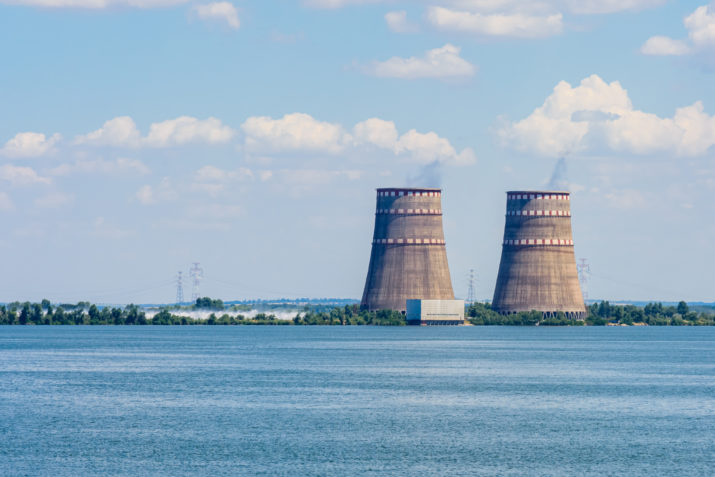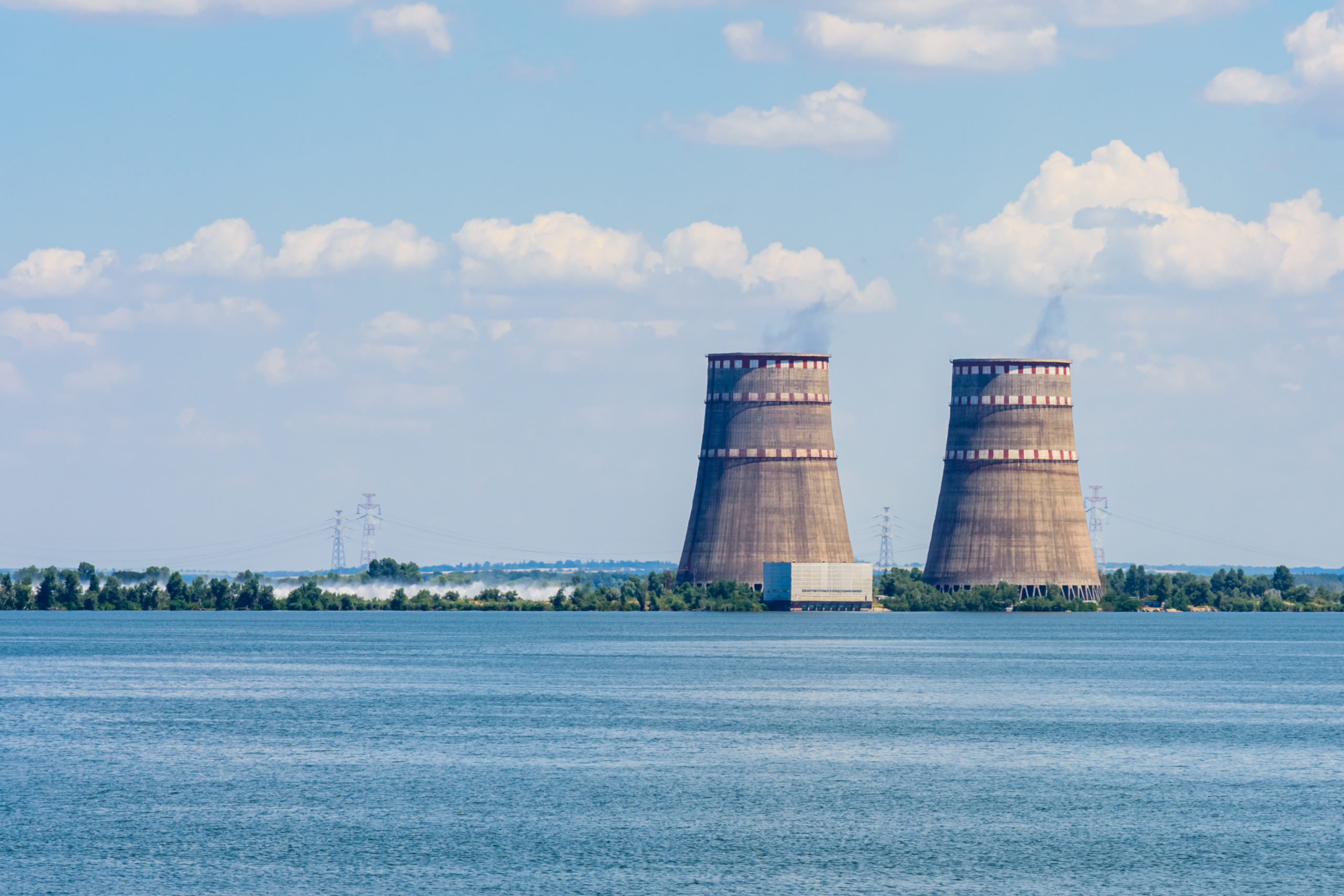

This is part of our special feature, The Frontlines of Environmental Politics in Europe.
During the night of March 3rd, 2022, Russian military forces advanced on the Zaporizhzhia Nuclear Power Station in southeastern Ukraine, seeking to occupy it on their way to establishing a secure land bridge between Crimea and the Russian mainland. Surveillance video footage showed that Russian forces fired weapons towards the plant’s reactors, which contained nuclear fuel, and set an administrative building on fire.[1]
Images of the plant burning caused horror around the world. Many observers, including Ukrainian President Volodymyr Zelenskyy, evoked the specter of Chernobyl. These horrifying images live in dialogue with the not-yet-done aftermath of the Chernobyl accident, which remains very close to many people in the region. These images have a particular resonance in Central and East Europe, where nuclear power has held a fraught position since the end of state socialism in 1989.
Postsocialist and newly accessed European Union countries, like Bulgaria, are constantly negotiating their geopolitical allegiances through their power grid: to rely on nuclear power means depending on Soviet-built and Russian-maintained infrastructures, but to look beyond nuclear often entails much-debated forms of power like shale gas extraction (fracking), coal, or Russian gas exports. When Russia recently cut the supply of gas to Bulgaria in retaliation for sanctions stemming from the invasion of Ukraine, it created new momentum for Bulgaria to find alternative sources of energy.[2] While these geopolitical machinations shape politics at one level, the everyday functioning of the Kozloduy Nuclear Power Plant in Northwest Bulgaria is very different from an on-the-ground perspective.
Although the accidents at Chernobyl and Zaporizhzhia make headlines, the structural violence surrounding the politics and technologies of these nuclear power plants—like Kozloduy—can be just as pernicious, especially for minoritized groups. Specifically, nuclear power catalyzes ultranationalist, far-right responses to both its production and consumption because it is deeply anchored in a racialized nostalgia for past (in Bulgaria, socialist) practices as well as contemporary global processes of racialization.
Putting studies of power and its techno-political materialities (e.g., Boyer 2019, Howe 2019, Rogers 2015) into dialogue with critical studies of race reveals that racialization takes shape through diverse material landscapes of inequality, which I collectively term infrastructural inequalities. As we have seen recently with the case of Zaporizhzhia, these inequalities exist on multiple levels: between nations, within nations, and in the everyday workings of nuclear power production.
In Bulgaria specifically, politicians connect aging power plants to right-wing political campaigns that merge national energy sources with nativist “whiteness,” energy diversification initiatives, and changing forms of racialized labor. Just as energy landscapes are transforming in conjunction with EU policy and international litigation, so too are understandings and practices of racialization. Roma throughout Bulgaria constantly refer to their positionality through a lens of race and racism despite many non-Romani Bulgarians disavowing race as a relevant emic category. In addition, right-wing groups in Bulgaria, often drawing on salient local issues of energy consumption and production, have begun to explicitly invoke a nativist language of “whiteness” in opposition to Roma and other minoritized groups.
Connections of energy and race in Bulgaria
Bulgaria is a critical site for studying the connections between energy infrastructures and racialization for multiple reasons. First, the country is undergoing rapid energy transformation. Nuclear energy is one of the most significant energy industries both in Bulgaria and worldwide—it accounts for approximately one-third of all energy produced for electricity usage in Bulgaria (EU 2014 Country Report) and 11 percent of electricity worldwide. From 1946 to 1989, a socialist government closely aligned with the Soviet Union governed Bulgaria. The Soviet Union funded the construction of the Kozloduy Nuclear Power Plant, consequently making Bulgaria reliant on Soviet—and then Russian—technology and expertise for its energy needs. Bulgaria “transitioned” from socialism to market-based capitalism in the 1990s and 2000s, joining the EU as a member state in 2007. Like energy regimes across the globe, including the United States as well as countries in Latin America and the Middle East, the Bulgarian state tied energy sector reform to national development, rapid industrialization, and hyper-modernization. In preparation for and since EU accession in 2007, Bulgaria has had to comply with energy diversification programs that promote a “greener” and more diverse energy landscape. In practice, however, energy transition has resulted in increased racialized disparities in energy access that are most visible when comparing the conditions of Romani and non-Romani populations. Bulgaria is also a key site for looking at connections between energy infrastructures and race because it systematically denies the existence of race, yet the markers of systemic racism persist throughout all facets of Bulgarian life. Romani people, who comprise nearly 10 percent of Bulgaria’s population today, have been subject to intense racialization throughout Bulgarian history. At the height of Bulgarian state socialism in the 1980s, the speaking of Romani was outlawed in Bulgaria, and citizens with Turkish names (including many Roma) were forced to adopt new “Bulgarian” names or risk expulsion from the country. These policies of total assimilation were enshrined in Bulgaria’s postsocialist democratic institutions, such as the purposeful omission of ethnic/racial identities from official state and census information. The material impacts of Bulgaria’s institutionalized racism—on labor practices (Resnick 2015, 2021), living conditions (Ivancheva 2015), and development initiatives (Vincze et al. 2015)—are well-documented, as is how race and white supremacy informs the development of nationalist political platforms in the country (Ivanov 2012, Todorov and Krasteva 2011, Rucker-Chang 2018). At the same time, Bulgarian society understands energy use as a proxy for national belonging from which Roma are systematically denied (cf. Sigona and Trehan 2009, Lemon 2000, Yıldız and De Genova 2018). And as these conditions persist, Bulgarian citizens and the state itself vehemently disavow the importance of race in everyday life, akin to “non-racial” or “post-racial” narratives that have emerged in the United States and elsewhere around the world (Pierre 2012, Saldivar 2012, Sayyid 2017).
Institutional racism, gender, and nuclear power
The racialization of Bulgarian Roma is highly gendered. Romani women have become the face of “the Roma problem” throughout Europe, and Bulgarian politicians often use absurdist data to provoke demographic fears of “G*psy overpopulation.” Bulgaria’s energy sector —its management, development, and the policies guiding it —affects the racialization of Roma (and particularly Romani women) in critical ways. For one, the ongoing decommissioning of Bulgaria’s nuclear power plant reactors compounds the economic and social marginalization of Romani women. Rapid deindustrialization has driven Bulgarian women to seek formal employment in increasingly hazardous lines of work, including in the nuclear sector. For example, the city of Kozloduy employed a great deal of women in its nuclear power plant during the socialist period. Yet, Romani women were and still are discriminated against in employment practices throughout Bulgaria.[3] Moreover, Romani women constitute the bulk of waste sector labor in Bulgaria (Resnick 2021). As a result, Romani women in towns like Kozloduy are disproportionately exposed to high levels of toxicity as they work with waste, both inside and on the edges of Kozloduy’s reactors, while also excluded from the kind of labor that affords white Bulgarian women in Kozloduy a kind of “high-risk affluence” (Brown 2013).
Bulgaria’s pending energy diversification initiatives also perpetuate the racialization of Roma (as non-citizens/“non-Europeans”). My research shows that much of Bulgarian society understands energy use as a proxy for citizenship and national belonging. This conceptualizing of citizenship in terms of energy use furthers the political marginalization of Roma. Energy poverty disproportionately affects Bulgaria’s Romani communities (Babourkova 2016, Harper, Steger, Filcak 2009, National Roma Integration Strategy of the Republic of Bulgaria 2012-2020). Electricity bills are often the highest fixed cost for Romani households, and electricity is nearly impossible to sustainably collect from other sources. Bulgarian politicians and media have used Romani energy poverty to popularize the notion of “G*psy” electricity theft, subsequently subjecting Romani neighborhoods to unexpected electricity rationing, shut offs, and other measures that reveal the persistent racialization of energy access.
At the same time, discussions regarding nuclear power in Bulgaria have popularized racialized nostalgia for past (socialist) practices in which race, due to policies of total assimilation, was deemed nonexistent. This discourse omits the existence of Roma, except as a threat to Bulgaria’s “green energy” future. It is also consistent with efforts by the global far-right to frame energy and other heartland industries as signs of a better, more racially homogenous past that should be safeguarded from foreigners and minorities in the future.
What next? Delocalization
The relationship between race and energy in Bulgaria speaks to similar phenomena worldwide, where both industry and deindustrialization catalyze intersectional environmental injustice. In many cases across the globe, local relations to toxicity are a function of intersectional inequalities; that is, we see toxic harms affecting people differently at the intersections of class, gender, race, and religion. This happens across Europe (Harper 2006, Gille 2016, Stoetzer 2018) and across the globe, including South Asia (Fortun 2011), North America (Fennell 2015, Voyles 2015), the Caribbean (Agard-Jones 2012, 2013), and South America (Graeter 2017). Indeed, racialized energy labor in Bulgaria is similar in form to that facing communities of color around the world. For example, many Latinx and Black communities working near industrial plants in California are exposed to toxic harm without reaping the economic benefits afforded to white workers at those same plants. In direct response to Aisha Beliso‐De Jesús and Jemima Pierre’s (2019) call for a de-fetishization of “ethnographic localization,” my ongoing work uses findings in Bulgaria to create a toolkit for developing transnational public outreach and collaborative energy justice advocacy networks. By addressing infrastructural inequalities across the globe, this project attempts to delocalize what I have observed in Bulgaria and put it into direct dialogue with other sites facing similar issues. As such, I am working on an approach to the study of energy that uses the race-energy intersection as its primary analytic. This approach attends to the important and often invisible aspects of daily experiences with energy based in racial, gendered, and other forms of inequality. Ultimately, I move forward by questioning how the labor and life of energy (e.g., its production, storage, consumption) provides data about how inequalities take shape and become material. And so, we must ask: how might examining energy infrastructures, across states and continents, help us to de-fetishize the locality of different manifestations of white supremacy to see them in a global constellation? In doing so how might we attune ourselves more to the transnational nature of energy infrastructures and their related inequalities—and what might this reveal?
Elana Resnick is an Assistant Professor of Anthropology at the University of California, Santa Barbara where she also serves as the director of the Infrastructural Inequalities Research Group (IIRG). She earned a PhD in Anthropology from the University of Michigan, Ann Arbor. She was previously a Weatherhead Resident Scholar at the School for Advanced Research (2014-2015), a Global Europe Research Scholar at the Wilson Center (2015), and a Postdoctoral Fellow at the Havighurst Center for Russian and Post-Soviet Studies (2016-2017). Her work focuses on race, waste, energy, Europeanization, and the everyday politics of resistance and refusal.
References
[1] https://www.npr.org/2022/03/11/1085427380/ukraine-nuclear-power-plant-zaporizhzhia
[2] https://www.reuters.com/business/energy/gazprom-says-it-halts-gas-supplies-poland-bulgaria-payments-row-2022-04-27
[3] https://fra.europa.eu/sites/default/files/fra_uploads/fra-2014-roma-survey-dif-women-2_en.pdf
Agard-Jones, Vanessa. 2012. “What the Sands Remember.” GLQ: A Journal of Lesbian and Gay Studies 18 (2–3): 325–346.
———. 2013. “Bodies in the System.” Small Axe: A Caribbean Journal of Criticism 17 (3 (42)): 182–192.
Babourkova, Rosalina. 2016. “Plovdiv:(De-) Racialising Electricity Access? Entanglements of the Material and the Discursive.” In Energy, Power and Protest on the Urban Grid, 45–63. London: Routledge.
Beliso‐De Jesús, Aisha, and Jemima Pierre. 2019. “Anthropology of White Supremacy.” American Anthropologist 122 (1): 65-75.
Boyer, Dominic. 2019. Energopolitics. Durham, NC: Duke University Press.
Brown, Kathryn. 2013. Plutopia: Nuclear Families, Atomic Cities, and the Great Soviet and American Plutonium Disasters. Oxford: Oxford University Press.
Chelcea, Liviu, and Gergo Pulay. 2015. “Networked Infrastructures and the ‘local’’: Flows and Connectivity in a Postsocialist City.’” City 19 (2–3): 344–355.
Collier, Stephen. 2011. Post-Soviet Social: Neoliberalism, Social Modernity, Biopolitics. Princeton, NJ: Princeton University Press.
Fennell, Catherine. 2015. Last Project Standing: Civics and Sympathy in Post-Welfare Chicago. Minneapolis: University of Minnesota Press.
Ferguson, James and Akhil Gupta. 2002. “Spatializing States: Toward an Ethnography of Neoliberal Governmentality.” American Ethnologist 29(4): 981-1002.
Fortun, Kim. 2001. Advocacy after Bhopal: Environmentalism, Disaster, New Global Orders. Chicago: University of Chicago Press.
Gille, Zsuzsa. 2016. Paprika, Foie Gras, and Red Mud: The Politics of Materiality in the European Union. Bloomington: Indiana University Press.
Graeter, Stefanie. 2017. “To Revive an Abundant Life: Catholic Science and Neoextractivist Politics in Peru’s Mantaro Valley.” Cultural Anthropology 32 (1): 117–148.
Harper, Krista. 2006. “Wild Capitalism: Environmental Activism and Postsocialist Political Ecology in Hungary.” Anthropology Department Faculty Publication Series, 81.
Harper, Krista, Tamara Steger, and Richard Filčák. 2009. “Environmental Justice and Roma Communities in Central and Eastern Europe.” Environmental Policy and Governance 19 (4): 251–268.
Howe, Cymene. 2019. Howe, Cymene. Ecologics. Durham, NC: Duke University Press.
Ivancheva, Mariya. 2015. “From Informal to Illegal: Roma Housing in (Post-) Socialist Sofia. Intersections.” East European Journal of Society and Politics 1 (4): 38-54.
Ivanov, Angel. 2012. “Antigypsyism in Bulgaria.” New Faces of Antigypsyism in Modern Europe: 49.
Lemon, Alaina. 2000. Between Two Fires: Gypsy Performance and Romani Memory from Pushkin to Post-Socialism. Durham, NC: Duke University Press.
Petryna, Adriana. 2013. Life Exposed: Biological Citizens after Chernobyl. Princeton, NJ: Princeton University Press.
Pierre, Jemima. 2012. The Predicament of Blackness: Postcolonial Ghana and the Politics of Race. Chicago: University of Chicago Press.
Resnick, Elana. 2015. “Discarded Europe: Money, Trash and the Possibilities of a New Temporality.” Anthropological Journal of European Cultures 24 (1): 123–131.
———.2021. “The Limits of Resilience: Managing Waste in the Racialized Anthropocene.” American
Anthropologist 123 (2): 222-236.
Rogers, Douglas, 2015. The Depths of Russia: Oil, Power, and Culture After Socialism. Ithaca, NY: Cornell University Press.
Rucker-Chang, Sunnie. 2018. “Challenging Americanism and Europeanism: African-Americans and Roma in the American South and European Union ‘South’.” Journal of Transatlantic Studies 16 (2): 181-199.
Saldívar, Emiko. 2014. “‘It’s Not Race, It’s Culture’: Untangling Racial Politics in Mexico.” Latin American and Caribbean Ethnic Studies 9 (1): 89–108.
Sayyid, Salam. 2017. “Post-racial Paradoxes: Rethinking European Racism and Anti-Racism.” Patterns of Prejudice 51 (1): 9-25.
Sigona, Nando, and Nidhi Trehan. 2009. Romani Politics in Contemporary Europe. London: Palgrave Macmillan.
Stoetzer, Bettina. 2018. “Ruderal Ecologies: Rethinking Nature, Migration, and the Urban Landscape in Berlin.” Cultural Anthropology 33 (2): 295–323.
Todorov, Antony, and Anna Krasteva. 2011. “Ethnic Minorities and Political Representation: The Case of Bulgaria.” Southeastern Europe 35 (1): 8-38.
Vincze, Eniko, Attila Bartha, and Tünde Virág. 2015. “Theoretical Potential of Addressing Production of Marginality at the Crossroads of Spatial Exclusion and Development.” Intersections. East European Journal of Society and Politics 1 (4): 4–13.
Voyles, Traci Brynne. 2015. Wastelanding: Legacies of Uranium Mining in Navajo Country. Minneapolis, MN: University of Minnesota Press.
Yıldız, Can, and Nicholas De Genova. 2018. Un/Free Mobility: Roma Migrants in the European Union. Oxfordshire: Taylor & Francis.
Published on May 18, 2022.




